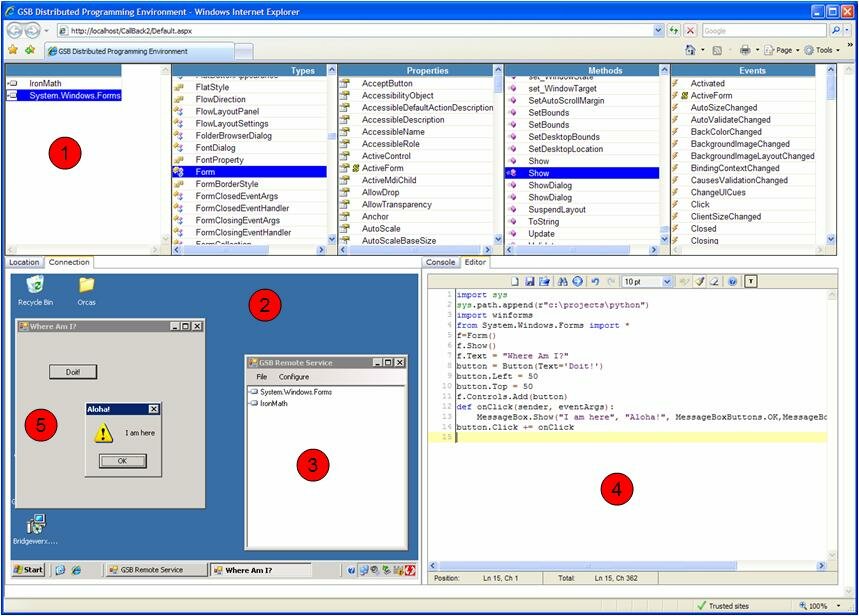This is an open source software project that is highly experimental. In fact, it might be just plain crazy. Our industry is a buzz about Web 2.0, SOA, distributed computing, etc. Yet, what tools do we have to support distributed programming?
What I mean by distributed programming is the ability to program multiple remote computers (i.e. servers) from within one IDE instance, or as I call it, a DPE – Distributed Programming Environment:

This ASP.NET AJAX DPE consists of the following parts labeled in red:
1) An Object or Class Bowser, similar to Lutz Roeder's outstanding Reflector, except mine is laid out in the old school Smalltalk System Brower format. Where are the assemblies IronMath and System.Windows.Forms coming from?
2) This is a Remote Desktop Connection (RDC) that allows connections to multiple remote computers. One tab per connection.
3) This is a Windows Forms application (or service if you will) that runs on the remote computer(s) that allows you to add assemblies to be reflected. It uses Windows Communication Foundation (WCF) to communicate with the web server hosting the DPE, which then displays the reflected assembly information in the browser window GridViews. In addition, this Windows Forms application hosts IronPython (and soon the DLR) which also communicates with the web server via WCF so that IronPython code can be executed on the remote server(s).
4) An IronPython source code editor which provides syntax highlighting, handling multiple source code files, etc. Again, using WCF to communicate with the IronPython DLL that is running on the remote server(s).
5) Is the result of running the IronPython code that is displayed in the editor window.
6) To find remote computers, I use Virtual Earth’s map control to display remote computer locations. Optionally, a MapPoint Web Service can be used to upload custom locations and attributes.
7) Oh yeah, an interactive command line console is a must have.

The context of which remote computer I am programming is activated by which tab has been selected. Meaning that when I click on any tab, any related context, like other dependant tabs and grids are switched too. I add distributed computers by adding tabs for each RDC session, a source code editor, and an interactive interpreter (i.e. console) per remote computer.
Think of the web server as a middle-tier to the WCF enabled remote services that host’s the code for reflecting assemblies and executing Python code.
As I mentioned earlier, I will be embedding the DLR which will add support for more dynamic languages. Also note that the web-based console window is generic in the sense that it can be a console to a remote cmd window or PowerShell window or… Same goes for the source code editor, its syntax highlighting also supports multiple languages.
Like I say, it will either be useful or just plain crazy. That’s why I call it Global System Builder 
January 30, 2008 Update - Global System Builder is available for download at: http://www.codeplex.com/gsb/
Official web site: http://globalsystembuilder.com